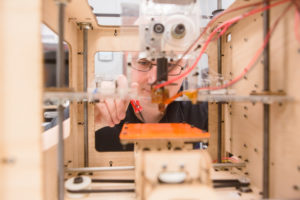As 3D printing technology continues to improve, companies are finding new ways to test its limits beyond just printing replacements of regularly used products. Michelin, for example, has made a concept tire that’s airless. With an internal webbing matrix replacing the air of a standard tire, the prototype can’t go flat, saving motorists from headaches and keeping schedules for trucking businesses intact. If the design becomes part of Michelin’s regular production, industry experts anticipate Michelin printing tires for specific conditions such as snow or heavy rain, thus customizing the tire for various markets. Printing products that remove the need for an outside element (such as the airless tire) could completely restructure the way certain industries operate. Below, we speculate on a few industries that could be fundamentally changed by 3D printing.
- Office Furniture – With a few measurements, practically any office chair could be customized and printed for a person’s weight, height, spinal alignment and more.
- Prosthetics – Much of the industry features components that are customized to fit the wearer, and printing in the prosthetic realm is starting to take off. 3D printing prosthetics on a larger scale could allow every limb to be made from scratch to match existing limbs, muscle tone, skin tone, etc.

- Construction – Awkward wall dimensions or uneven surfaces could be remedied by printing hardware, support boards and more, all designed and printed to specifically fit unique spaces and cut down on usage of natural resources.
- Electronics – Developing circuit boards for various electronics requires a lot of minerals and resources that are hard to extract and harder to dispose of properly. Printed circuit boards would save those resources and allow for more compact electrical engineering.
- Food – Ingredients that sit on a shelf until used can be printed into food. 3D printing could change the way dry goods are marketed, packaged, transported and consumed.
- Infrastructure – Irrigation parts, specifically, could be printed on-site in rural areas that lack widespread access to modern amenities and utilities.
- Military – Given the unique needs of military forces, 3D printing would allow them quick access to replacement or accessory parts for machinery, weaponry and tools.
While 3D printing is still more concept than standard practice, its viability as a new means of manufacturing and product evolution is being proven on a regular basis. How do you anticipate 3D printing changing the way tried-and-true industries manufacture their products? Share your thoughts with us in the comments section below.
